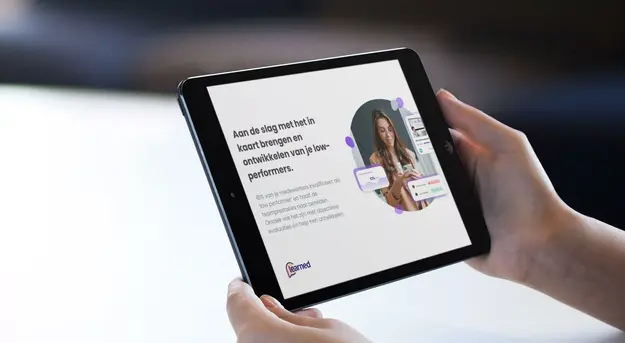Many companies use an appraisal method that assumes one appraisal interview. Being told once a year how you performed in the past year does not contribute to good mutual cooperation and, more importantly, often causes employees not to develop (further). More and more companies want to increase the number of feedback moments and strive for a true feedback culture. But how do you actually create a feedback culture?
What is a feedback culture?
A feedback culture is a work environment in which an employee feels safe and comfortable asking for and giving feedback on a frequent basis. Feedback causes employees to engage in dialogue with each other and largely determines the atmosphere in the workplace. In addition, goals are achieved more quickly when employees continue to develop on the job and therefore can work better with other colleagues.
Feedback can be divided into 2 categories. Feedback during appraisal and interview rounds and spontaneous feedback that can be used between interviews to provide on-the-job feedback. A constructive way to use feedback during the interview process is the 360-degree feedback method. Through this 360-degree feedback, employees actively solicit feedback from colleagues, supervisor and even external (clients). The benefits are much higher engagement from employees and it allows employees to grow and develop without additional investment. Download our e-guide on “real-time insight into your high performers’ employee engagement“ to discover how to measure, interpret and improve engagement so you retain the best talent and save costs.
What is the added value of a feedback culture?
By providing constructive feedback during one of the development meetings during the year, the assessment at the end of the year does not come as a surprise. When employees are provided with feedback on behavior and performance in a constructive and positive manner, it ensures that they continue to develop. This in turn means that employees will perform better, and this is not only good for the employee himself but also for the organization.
Research from Gallup(How millennials want to work, 2016) and Deloitte(2018 Millennial Survey), among others, shows that new generations value ongoing conversations, alignment with business strategy and continuous feedback much more.
New generations like Millennials want to receive feedback more often and more frequently. They are constantly curious about whether they are doing well or not. This generation is used to communicating more directly. Having grown up with likes, dislikes, and reviews, it makes sense that they also feel the need to give, as well as receive, feedback at work.
Feedback is no longer synonymous with negative criticism but enables all the more to work on personal development and growth.
Securing qualitative feedback
Using different models or templates can help secure quality feedback. For example, you can apply the “Start, stop and continue method” for giving feedback in a positively constructive way. The goal is to foster a feedback culture and exchange feedback among themselves using a format that includes three principles that keep the focus on the employee’s positives and talents. What should the employee start, stop and continue with?
If you want to provide specific feedback on certain behaviors and what effect those behaviors have use “the 4G feedback method” to create a constructive feedback culture.
The 4G model feedback consists of four Gs:
- Behavior: actual specific behavior of the other person
- Consequence: the effect of a person’s behavior on the environment
- Feeling: feeling reflection of what the other person’s behavior triggers in you.
- Desired: Name the behavior you would like to see.
Giving feedback is a powerful method for increasing employee performance and engagement. At the same time, it is also one of the most difficult activities in the workplace. Whether as a manager to a team member or to an immediate colleague. Many find giving feedback difficult and exciting.
Use supportive HR software to create a successful feedback culture
A successful feedback culture hinges on the continuity of soliciting feedback. It takes an awful lot of time to get a feedback culture embedded in the corporate culture. The use of supporting HR software, such as Learned’s platform, helps accelerate and facilitate this process. Deploy online tooling to actively encourage employee development so they can actively solicit feedback and set their own goals. This creates responsibility and ownership
Learned’s HR performance management tooling for an ongoing dialogue about work happiness, performance and behavior contributes to a more frequent exchange of feedback. Learned’s 2021 user research shows that up to 65% more feedback is provided by using Learned’s software. Also, more than 80% of those surveyed say they have a greater understanding of skills and abilities through the use of Learned. This means much more engaged employees, faster anticipation of potential problems and greater job happiness.

With Learned’s AI, you easily generate a modern job board based on market data. This makes evaluations objective and career opportunities transparent.
Supporting HR software from Learned
To realize this, Learned helps you revamp your HR Cycle and you easily design your ideal feedback form with feedback based on goals, open-ended questions or even core values, competencies and skills. For each type of question, you decide what form of feedback you want to apply; 90°, 180° 360° feedback or even feedback from externals (clients etc). To ensure that as a manager you no longer have to chase employees down, set up automatic reminders that take that work from you and have all feedback and conversation notes in one central place.
Furthermore, digitally signing forms in the Learned Platform eliminates the need for paper printouts! In addition, Learned offers the ability to encourage employees, for example, to ask a colleague for spontaneous feedback each week. This is how you all work toward a true culture of feedback.
Wondering how these best practices can be used in your organization? Watch a video demo of the Learned platform or create a free trial account here.







